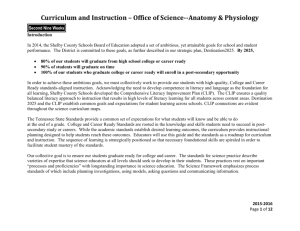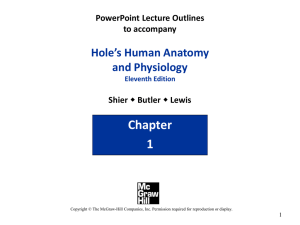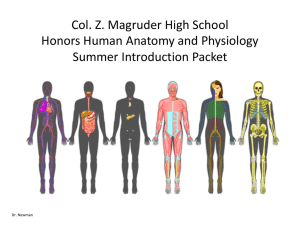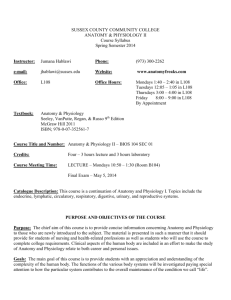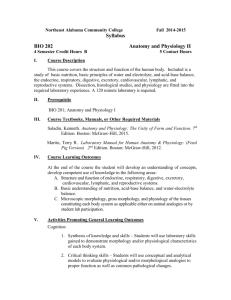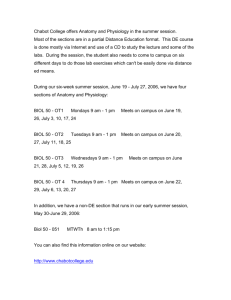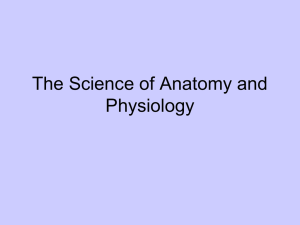Gulp (Don`t Gag): Modeling the Complexity of the Digestive System
advertisement
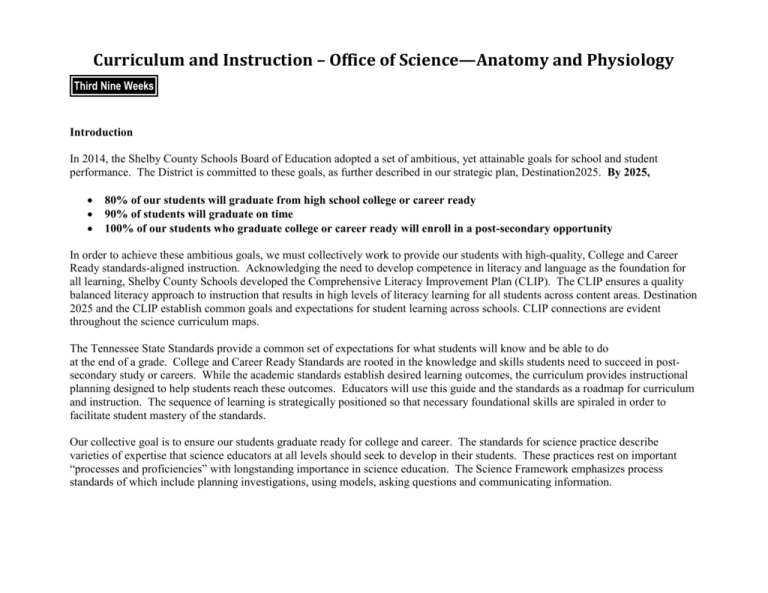
Curriculum and Instruction – Office of Science—Anatomy and Physiology Third Nine Weeks Introduction In 2014, the Shelby County Schools Board of Education adopted a set of ambitious, yet attainable goals for school and student performance. The District is committed to these goals, as further described in our strategic plan, Destination2025. By 2025, 80% of our students will graduate from high school college or career ready 90% of students will graduate on time 100% of our students who graduate college or career ready will enroll in a post-secondary opportunity In order to achieve these ambitious goals, we must collectively work to provide our students with high-quality, College and Career Ready standards-aligned instruction. Acknowledging the need to develop competence in literacy and language as the foundation for all learning, Shelby County Schools developed the Comprehensive Literacy Improvement Plan (CLIP). The CLIP ensures a quality balanced literacy approach to instruction that results in high levels of literacy learning for all students across content areas. Destination 2025 and the CLIP establish common goals and expectations for student learning across schools. CLIP connections are evident throughout the science curriculum maps. The Tennessee State Standards provide a common set of expectations for what students will know and be able to do at the end of a grade. College and Career Ready Standards are rooted in the knowledge and skills students need to succeed in postsecondary study or careers. While the academic standards establish desired learning outcomes, the curriculum provides instructional planning designed to help students reach these outcomes. Educators will use this guide and the standards as a roadmap for curriculum and instruction. The sequence of learning is strategically positioned so that necessary foundational skills are spiraled in order to facilitate student mastery of the standards. Our collective goal is to ensure our students graduate ready for college and career. The standards for science practice describe varieties of expertise that science educators at all levels should seek to develop in their students. These practices rest on important “processes and proficiencies” with longstanding importance in science education. The Science Framework emphasizes process standards of which include planning investigations, using models, asking questions and communicating information. Curriculum and Instruction – Office of Science—Anatomy and Physiology Third Nine Weeks Construct explanations and design solution Obtain, evaluate, and communicate information Engage in argument Ask questions and define problems Patterns Develop and use models Practices in Science Use math, technology, and computational thinking Plan and carry out investigations Cause and Effect Stability and change Cross Cutting Concepts Analyze and interpret data Energy and matter Systems and system models Crosscutting concepts have value because they provide students with connections and intellectual tools that are related across the differing areas of disciplinary content and can enrich their application of practices and their understanding of core ideas. Throughout the year, students should continue to develop proficiency with the eight science practices. Crosscutting concepts can help students better understand core ideas in science and engineering. When students encounter new phenomena, whether in a science lab, field trip, or on their own, they need mental tools to help engage in and come to understand the phenomena from a scientific point of view. Familiarity with crosscutting concepts can provide that perspective. A next step might be to simplify the phenomenon by thinking of it as a system and modeling its components and how they interact. In some cases it would be useful to study how energy and matter flow through the system, or to study how structure affects function (or malfunction). These preliminary studies may suggest explanations for the phenomena, which could be checked by predicting patterns that might emerge if the explanation is correct, and matching those predictions with those observed in the real world. Curriculum and Instruction – Office of Science—Anatomy and Physiology Third Nine Weeks Science Curriculum Maps This curriculum map is designed to help teachers make effective decisions about what science content to teach so that, our students will reach Destination 2025. To reach our collective student achievement goals, we know that teachers must change their instructional practice in alignment with the three College and Career Ready shifts in instruction for science. To ensure that all student will be taught science content and processes in a comprehensive, consistent, and coherent manner, Science Curriculum Maps are provided. Foundation texts for the maps include Shelby County Schools Framework for Standards Based Curriculum, Science Curriculum Frameworks-K-12 (State of Tennessee Board of Education, and National Science Education Standards). Teachers function most effectively and students learn best within an “aligned” curriculum delivery system. An aligned system begins with a concerted effort to implement the state curriculum frameworks. Many districts have developed curriculum guides built around these frameworks to ensure that what is taught in particular grades and courses is closely linked with student Learning Expectations found in the state standards. Classroom teachers use these locally-generated curriculum guides to plan and implement their individual grade or course Pacing Guides. Expectations for student performance are clear and carefully tied to daily instructional events and classroom assessment practices. In theory, a fully aligned system closes the loop between state standards and student learning. Additionally, a coherent instructional/assessment system offers the potential for heightening student learning as reflected by their performance on state-mandated standardized tests. Our collective goal is to ensure our students graduate ready for college and career. Most of the elements found in the state Curriculum Frameworks were incorporated into the curriculum mapping material prepared by Shelby County Schools. Additional features were included to add clarity and to offer avenues that could assist teacher in developing grade level lessons. A district-wide, K-12, standards-based curriculum is implemented in science. This curriculum is articulated in the form of individual SCS curriculum maps for each grade and subject. These SCS curriculum maps enable the district to implement a single curriculum that emphasizes specific standards. Since Shelby County has a high rate of mobility among the student population, the SCS curriculum maps ensure that all students receive the same program of high-level instructional content and academic expectations, regardless of which school they attend. The utilization of a district-wide standards-based curricular program ensures that students in SCS are engaged in hands-on inquiry based activities as teachers implement the curriculum map. High School Science: Curriculum Map for Anatomy and Physiology Third Nine Weeks State Standards Embedded Standards Outcomes Resources Connections Unit 3.1 Blood – 1.5 Weeks CLE 3251.4.1 Identify the molecular and cellular components of the blood and the functions of the blood. CLE 3251.Inq.1 Recognize that science is a progressive endeavor that reevaluates and extends what is already accepted. CLE 3251.Inq.3 Use appropriate tools and technology to collect precise and accurate date CLE 3251.Inq.6 Communicate and defend scientific findings. CLE 3251.Inq.5 Compare experimental evidence and conclusions with those drawn by others about the same testable question. Describe the cellular components and physical characteristics. Determine blood types in ABO systems. Compare the molecular affinity of hemoglobin to oxygen and carbon monoxide in terms of maintain homeostasis. 1. Hole’s Human Anatomy and Physiology Chapter 14 2. www.mhhe.com/shier12 3. http://www.biologycorner.com/anat omy/chap12.html 4. Student Study Guide – Blood- pp. 139-149 5. Blood Cells – Laboratory Manual pp. 303-311 6. Blood Testing –A Demonstration – Laboratory Manual pp. 313-326 7. Virtual Lab: http://www.classzone.com/cz/books /bio_07/chapter_home.htm?cin=30 http://www.pleasanton.k12.ca.us/av hsweb/turner/webdoc/Biology/activi ties/BloodTypingWS.pdf (Worksheet) Cite specific textual evidence to support analysis of science and technical texts, attending to important distinctions the author makes and to any gaps or inconsistencies in the account. Evaluate the hypotheses, data, analysis, and conclusions in a science or technical text, verifying the data when possible and corroborating or challenging conclusions with other sources of information. NGSS Practices 1. Asking question and defining problems 2. Designing and using models 8. The Science Behind the Story http://www.storybehindthescience.o rg/pdf/howtouse.pdf 4 2015-2016 High School Science: Curriculum Map for Anatomy and Physiology Third Nine Weeks State Standards Embedded Standards Learning Outcomes Resources Connections Unit 3.2 Cardiovascular System – 4 Weeks CLE 3251.4.2 Explore the anatomy of the heart and describe the pathway of blood through this organ. CLE 3251.Inq.1 Recognize that science is a progressive endeavor that reevaluates and extends what is already accepted. CLE 3251.4.3 Describe the biochemical and physiology nature of heart function. CLE 3251.Inq.3 Use appropriate tools and technology to collect precise and accurate date CLE 3251.4.4 Describe the relationship between the structure and function of different types of blood vessels. CLE 3251.4.5 Describe the physiological basis of circulation and blood pressure. CLE 3251.Inq.6 Communicate and defend scientific findings. CLE 3251.Inq.5 Compare experimental evidence and conclusions with those drawn by others about the same testable question. Describe the different types of blood vessels. Identify the major arteries and veins, Prepare a model that illustrates the layers, chambers, and valves of the heart. Describe the biochemical and physiological events associated with heart contraction, blood pressure, and blood clotting. Draw a diagram that traces the pathway of blood through the heart and lungs. Measure the blood pressure and the pulse rates. 1. Hole’s Human Anatomy and Physiology Chapter 15 2. Student Study GuideCardiovascular System pp. 150161. 3. www.mhhe.com/shier15 4. http://www.biologycorner.com/anat omy/chap13.html Cite specific textual evidence to support analysis of science and technical texts, attending to important distinctions the author makes and to any gaps or inconsistencies in the account. Evaluate the hypotheses, data, 5. http://www.getbodysmart.com/ap/s analysis, and conclusions in a science or technical text, ystems/tutorial.html verifying the data when possible and corroborating or 6. The Science Behind the Story http://www.storybehindthescience. challenging conclusions with other sources of information. org/pdf/howtouse.pdf 7. Anatomy and Physiology Revealed vol. 3: Cardiovascular System 8. Heart Attack Video www.unitedstreaming.com NGSS Practices 1. Asking question and defining problems 2. Designing and using models 9. Laboratory Manual Heart Structure p. 327-335 Cardiac Cycle p. 337-343 Pulse Rate and Blood Pressure pp. 353-356 Vernier Physiology –Blood Pressure # 7 and 8 5 2015-2016 High School Science: Curriculum Map for Anatomy and Physiology Third Nine Weeks State Standards Embedded Standards Outcomes Resources Connections Unit 3.3 Respiratory System – 1.5 Weeks CLE 3251.4.2 Explore the anatomy of the heart and describe the pathway of blood through this organ. CLE 3251.Inq.1 Recognize that science is a progressive endeavor that reevaluates and extends what is already accepted. CLE 3251.4.3 Describe the biochemical and physiology nature of heart function. CLE 3251.Inq.3 Use appropriate tools and technology to collect precise and accurate date CLE 3251.4.4 Describe the relationship between the structure and function of different types of blood vessels. CLE 3251.4.5 Describe the physiological basis of circulation and blood pressure. CLE 3251.Inq.6 Communicate and defend scientific findings. CLE 3251.Inq.5 Compare experimental evidence and conclusions with those drawn by others about the same testable question. Describe the cellular components and physical characteristics. Compare the molecular affinity of hemoglobin to oxygen and carbon monoxide in terms of maintain homeostasis. Describe the biochemical and physiological events associated with heart contraction, blood pressure, and blood clotting. Draw a diagram that traces the pathway of blood through the heart and lungs. Measure the blood pressure and the pulse rates. 1. Hole’s Human Anatomy and Physiology Chapter 19 2. www.mhhe.com/shier12 3. http://www.biologycorner.com/anat omy/chap16.html Cite specific textual evidence to support analysis of science and technical texts, attending to important distinctions the author makes and to any gaps or inconsistencies in the 4. http://www.getbodysmart.com/ap/s account. ystems/tutorial.html 5. The Science Behind the Story http://www.storybehindthescience. org/pdf/howtouse.pdf 6. How the Respiratory System Works http://www.nhlbi.nih.gov/health/he alth-topics/topics/hlw/system.html Evaluate the hypotheses, data, analysis, and conclusions in a science or technical text, verifying the data when possible and corroborating or challenging conclusions with other sources of information. NGSS Practices 1. Asking question and defining problems 8. Laboratory Manual Heart Structure p. 327-335 Cardiac Cycle p. 337-343 Pulse Rate and Blood Pressure pp. 353-356 Vernier Physiology – Respiratory Response to Physiologic Challenges - # 20 2. Designing and using models 7. Heart Attack Video www.unitedstreaming.com 6 2015-2016 High School Science: Curriculum Map for Anatomy and Physiology Third Nine Weeks State Standards Embedded Standards Outcomes Resources Connections Unit 3.4 Lymphatic System and Immunity – 2 Weeks CLE 3251.4.6 Identify the structures of the lymphatic system. CLE 3251.4.7 Describe the details of the immune response. CLE 3251.Inq.1 Recognize that science is a progressive endeavor that reevaluates and extends what is already accepted. CLE 3251.Inq.3 Use appropriate tools and technology to collect precise and accurate date CLE 3251.Inq.6 Communicate and defend scientific findings. CLE 3251.Inq.5 Compare experimental evidence and conclusions with those drawn by others about the same testable question. Describe the immune response mechanisms of at the cellular level. Relate nonspecific cellular and chemical defenses of the body to environmental factors. Identify the causes of imbalances in the immune system. Locate the six major areas of lymph nodes and identify the lymphatic system components. 1. Hole’s Human Anatomy and Physiology Chapter 16 2. Student Study Guide- Lymphatic System pp. 162-173. 3. www.mhhe.com/shier12 4. http://www.slideshare.net/1957Ha mlet/chapter-16-lymphatic-systemand-immunity-8712480 Cite specific textual evidence to support analysis of science and technical texts, attending to important distinctions the author makes and to any gaps or inconsistencies in the account. Evaluate the hypotheses, data, 5. http://www.getbodysmart.com/ap/s analysis, and conclusions in a ystems/tutorial.html science or technical text, verifying the data when 6. The Science Behind the Story http://www.storybehindthescience. possible and corroborating or challenging conclusions with org/pdf/howtouse.pdf other sources of information. 7. Anatomy and Physiology Revealed vol. 3: Lymphatic System NGSS Practices 8. Lymphatic System – Laboratory 1. Asking question and defining Manual – pp. 385-390 problems 2. Designing and using models 7 2015-2016 High School Science: Curriculum Map for Anatomy and Physiology Third Nine Weeks Unit 3.1 Transport Plans Blood http://www.biologycorner.com/anatomy/blood/notes_blood.html Blood Concept http://www.biologycorner.com/anatomy/blood/blood_concept_map.html Blood Disorders http://www.biologycorner.com/anatomy/blood/notes_blood_disorders.html Blood Typing http://www.biologycorner.com/anatomy/blood/notes_bloodtype.html The Circulatory System http://www.biologycorner.com/anatomy/circulatory/notes_ch13_cardiovascular.html Heart Actions http://www.biologycorner.com/anatomy/circulatory/notes_ch13_cardiac_cycle.html Digestive System http://www.biologycorner.com/anatomy/digestive/notes_digestive.html Gulp (Don’t Gag): Modeling the Complexity of the Digestive System http://learning.blogs.nytimes.com/2013/05/01/gulp-dont-gag-modeling-the-complexity-of-the-digestive-system/ The Respiratory System http://www.biologycorner.com/anatomy/respiratory/notes_respiratory_system.html Article: Everest/First Ascents: Altitude Danger Begins in Pheriche http://www.backpacker.com/everest_first_ascent/blogs/daily_dirt/910 8 2015-2016 High School Science: Curriculum Map for Anatomy and Physiology Third Nine Weeks Unit 3.1 Transport Background for Teachers Cardiac Risk in the Young (CRY) http://www.c-r-y.org.uk/cardiac_tests.htm Your Digestive System and How It Works http://digestive.niddk.nih.gov/ddiseases/pubs/yrdd/ The Digestive System http://www.emc.maricopa.edu/faculty/farabee/biobk/biobookdigest.html Human Digestive System http://www.enchantedlearning.com/subjects/anatomy/digestive/ Digestive System http://www.innerbody.com/image/digeov.html How the Respiratory System Works http://www.nhlbi.nih.gov/health/health-topics/topics/hlw/system.html Unit 3.1 Genetics of Blood Disorders Transport http://www.biologycorner.com/anatomy/blood/blood_disorder_genetics.html Student Activities Blood Typing (Use Simulated Blood) http://www.biologycorner.com/anatomy/blood/blood_typing_lab.html Label the Digestive System http://www.biologycorner.com/anatomy/digestive/digestive_labeling.html Digestive System concept Map http://www.biologycorner.com/anatomy/digestive/digestive_concept_map.html Digestive System Study Guide 9 2015-2016 High School Science: Curriculum Map for Anatomy and Physiology Third Nine Weeks http://www.biologycorner.com/anatomy/digestive/study_guide_digestive.html Respiratory System Study Guide http://www.biologycorner.com/anatomy/respiratory/review_ch16.html Measuring Blood Pressure http://www.biologycorner.com/worksheets/measuring_blood_pressure.html Unit 3.1 Transport Other Resources Circulatory System Review http://www.biologycorner.com/anatomy/circulatory/review_guide.html Presentation Slides of the Human Vessels https://docs.google.com/presentation/d/1e_CgGdQy61dYw3Y-lhvXK921WXbvzEhSf-f__7h2KhU/present#slide=id.i0 Virtual Anatomy Textbook: The Digestive System http://www.acm.uiuc.edu/sigbio/project/digestive/ 10 2015-2016
